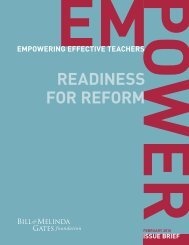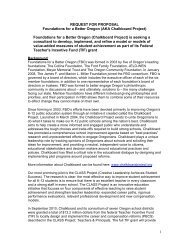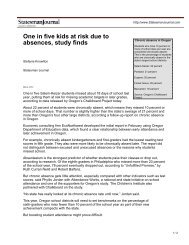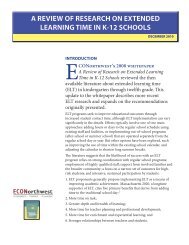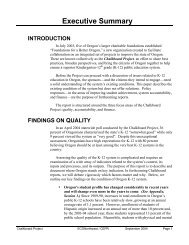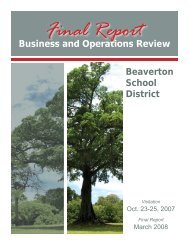TA P P I N G T H E P O T E N T I A L : R E TA I N I N G A N D D E V E L O P I N G H I G H - Q U A L I T Y N E W T E A C H E R Steachers’ education, certification, teaching assignments, professional development, collaboration,and supportive work environment. In addition, comparisons by instructionallevel and poverty level of <strong>the</strong> school provide in<strong>for</strong>mation about <strong>the</strong> distribution ofteacher quality. This in<strong>for</strong>mation provides a context <strong>for</strong> understanding teachers’reports of preparedness to meet <strong>the</strong> challenges <strong>the</strong>y face in <strong>the</strong>ir classrooms.National Center <strong>for</strong> <strong>Education</strong> Statistics. Progress Through <strong>the</strong> Teacher Pipeline:1992–93 College Graduates and Elementary/Secondary School Teaching as of 1997.Washington, D.C.: U.S. Department of <strong>Education</strong>, 2000.This report is <strong>the</strong> second in a series that follows 1992–93 college graduates’ progressthrough <strong>the</strong> teacher pipeline using data from <strong>the</strong> Second Follow-up of <strong>the</strong>Baccalaureate and Beyond Longitudinal Study (B&B:93/97). This report focuses on <strong>the</strong>academic characteristics and preparation <strong>for</strong> teaching of those who took various stepstoward teaching and is organized by a conceptual “teacher pipeline” that represents ateacher’s career. The pipeline includes preparatory activities—considering teaching, studentteaching as an undergraduate, becoming certified to teach, and applying <strong>for</strong>teaching jobs—as well as teaching experiences and plans <strong>for</strong> teaching in <strong>the</strong> future.National Center <strong>for</strong> <strong>Education</strong> Statistics. Attrition of New Teachers Among RecentCollege Graduates: Comparing Occupational Stability Among 1992–93 CollegeGraduates Who Taught and Those Who Worked in O<strong>the</strong>r Occupations. Washington,D.C.: U.S. Department of <strong>Education</strong>, 2001.This research examines <strong>the</strong> occupational stability of bachelor’s degree recipientsduring <strong>the</strong> first four years after receiving <strong>the</strong>ir degrees. The analyses address <strong>the</strong> question,were graduates who were teaching in 1994 more or less likely than those in o<strong>the</strong>roccupations to leave <strong>the</strong> work<strong>for</strong>ce or work in a different occupation in 1997? Thisreport aptly details <strong>the</strong> teacher attrition problem.National Commission on Teaching and America’s Future. No Dream Denied: APledge to America’s Children. Washington, D.C.: National Commission on Teachingand America’s Future, 2003.Building on <strong>the</strong>ir 1996 report What Matters Most, NCTAF examines <strong>the</strong> quality ofAmerica’s teaching profession through <strong>the</strong> lens of recruiting and retaining excellentteachers <strong>for</strong> every child. To ensure that “highly qualified” beginning teachers meet <strong>the</strong>high standards anticipated by <strong>the</strong> No Child Left Behind Act, <strong>the</strong> commission makesrecommendations about teacher preparation, <strong>the</strong> characteristics of schools to supportteacher learning, and hiring and support practices, including induction programs, toprovide benchmarks <strong>for</strong> overall teacher professional development.Public <strong>Education</strong> Network. The Voice of <strong>the</strong> New Teacher. Washington, D.C.: Public<strong>Education</strong> Network, 2003.This report contains research into <strong>the</strong> perspectives of new teachers on <strong>the</strong> quality ofteacher preparation, <strong>the</strong> first years of teaching, and supports provided by districts andschools during early years in <strong>the</strong> profession. Conducted in four communities—Chattanooga, Tennessee; New York, New York; Seattle, Washington; and Washington,D.C.—<strong>the</strong> research surveyed more than 200 teachers. New teachers made several rec-61
A L L I A N C E F O R E X C E L L E N T E D U C AT I O Nommendations regarding new teacher induction, including more support in learninghow to teach high-risk students (including special education and LEP students).Sanders, William, and June Rivers. Cumulative and Residual Effects of Teachers onFuture Student Academic Achievement. Knoxville: University of Tennessee Value-Added Research and Assessment, 1996.The study by statistician William Sanders finds that fifth graders who had beentaught <strong>for</strong> <strong>the</strong> previous three years by very effective teachers gained fifty percentilepoints more on a state’s assessment than those who had been taught by ineffectiveteachers. Students whose initial achievement levels are comparable have different academicoutcomes as a result of <strong>the</strong> sequence of teachers to which <strong>the</strong>y are assigned.Serpell, Zewelanji, and Leslie Bozeman. Beginning Teacher Induction: A Report onBeginning Teacher Effectiveness and Retention. Washington, D.C.: NationalPartnership <strong>for</strong> Excellence and Accountability in Teaching, 1999.This report discusses <strong>the</strong> effectiveness of induction programs and resulting outcomes<strong>for</strong> beginning teacher retention, beginning teacher effectiveness, and mentorparticipation. The various components of induction programs are provided, with indepthdiscussion of: <strong>the</strong> role of <strong>the</strong> mentor; characteristics of effective mentorship andof successful induction programs; release time; and program evaluation and assessment.Included are aspects of induction programs that administrators, mentors, andinductees identify as essential to a program’s success. Indicators of increased teachereffectiveness as <strong>the</strong>y resulted from programs in Cali<strong>for</strong>nia, Idaho, Montana, NorthCarolina, Wisconsin, and Toronto are detailed. Statistics showing high retention rates<strong>for</strong> inducted teachers are given <strong>for</strong> Texas, Cali<strong>for</strong>nia, Montana, and Wisconsin.Strong, Michael. A Study of New Teacher Retention: The Effects of Mentoring <strong>for</strong>Beginning Teachers. Santa Cruz, CA: University of Cali<strong>for</strong>nia, New Teacher CenterReport, 2001.This study examines sixty-three teachers eight or nine years after <strong>the</strong>y were enrolledin an induction support program that provided <strong>the</strong>m with veteran teachers releasedfull-time as mentors. A control sample of twenty-five teachers from neighboring districtsnot involved with a full-release mentoring program was also studied.Texas Center <strong>for</strong> <strong>Education</strong>al Research. The Cost of Teacher Turnover. Austin, TX:Texas Center <strong>for</strong> <strong>Education</strong>al Research, 2000.This is an analysis of teacher shortage and teacher turnover in <strong>the</strong> state of Texas.The study uses industry model estimates to gauge <strong>the</strong> cost of teacher turnover, includingseparation costs, hiring costs, and costs <strong>for</strong> training and supporting new employees.Using <strong>the</strong> most conservative model—25 percent of <strong>the</strong> leaving teacher’s salary—<strong>the</strong>report determines that Texas loses $329 million a year to turnover. Using o<strong>the</strong>r industrymodel estimates based on Texas teacher turnover rates, <strong>the</strong> state loses as much as$2.1 billion annually.62



